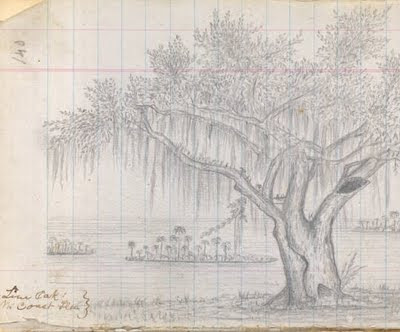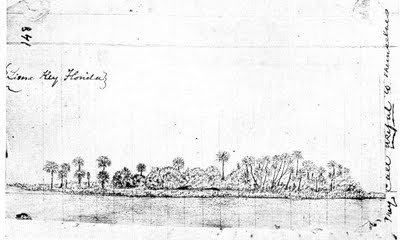John Muir and the Gulf of Mexico

John Muir's drawing of the Florida coastline. Photo credit: University of the Pacific, http://digitalcollections.pacific.edu/u?/muirjournals,75
Can there be a more significant week for the environment? Today would have been John Muir's 173rd birthday. Tomorrow is Earth Day. Yesterday was the one year anniversary of the Deepwater Horizon disaster in the Gulf of Mexico. Today BP shifted blame for the disaster by suing Transocean for $40 billion.
In fact, the idea for Earth Day came to U.S. Senator Gaylord Nelson after a trip to see the impact of the 1969 Santa Barbara offshore oil disaster. Wisconsin, the home state of the Senator was also the childhood home of John Muir in the New World.
For Muir, a key turning point was his arrival in Florida and specifically the smells and sights of the Gulf of Mexico. Cedar Key was the end of a long 1,000-mile walk to the Gulf from Indiana. It instantly transported him back to the rocky coast of his birth – Scotland.
To-day I reached the sea. While I was yet many miles back in the palmy woods, I caught the scent of the salt sea breeze which, although I had so many years lived far from sea breezes, suddenly conjured up Dunbar, its rocky coast, winds and waves; and my whole childhood, that seemed to have utterly vanished in the New World, was now restored amid the Florida woods by that one breath from the sea.

John Muir's sketch of Lime Key, in the Gulf of Mexico. Photo credit: John Muir Exhibit, Sierra Club, http://www.sierraclub.org/john_muir_exhibit/writings/a_thousand_mile_walk_to_the_gulf/
He further writes:
For nineteen years my vision was bounded by forests, but to-day, emerging from a multitude of tropical plants, I beheld the Gulf of Mexico stretching away unbounded, except by the sky. What dreams and speculative matter for thought arose as I stood on the strand, gazing out on the burnished, treeless plain!
The next day, Muir succumbed to Malaria. During his convalescence, he had time to stare at the Gulf, his polished "treeless plain" and think about how all of nature was interconnected.
The universe would be incomplete without man; but it would also be incomplete without the smallest transmicroscopic creature that dwells beyond our conceitful eyes and knowledge.
We all know the rest of the story. He visited Havana, Cuba, then travelled north to New York City and finally booked sea passage to California becoming one of the world's greatest environmental figures. But consider his prescient words as he passed the Straits of Florida:
We are apt to look out on the great ocean and regard it as but a half-blank part of our globe — a sort of desert, "a waste of water." But, land animals though we be, land is about as unknown to us as the sea, for the turbid glances we gain of the ocean in general through commercial eyes are comparatively worthless. Now that science is making comprehensive surveys of the life of the sea, and the forms of its basins, and similar surveys are being made into the land deserts, hot and cold, we may at length discover that the sea is as full of life as the land. None can tell how far man's knowledge may yet reach.
One could argue that a key transformation for Muir came at the end of his 1,000-mile walk to the Gulf. It was there at Cedar Key, when it all came into focus. He stared at the infinite plain, his mind clear and realized the world wasn't just there for man. It was there for all living creatures, and they all had a role to play.
We've all had similar mind-clearing experiences at the beach. The endless panorama allows us to think about the things that are truly important. The sea makes us feel small, humble. Muir felt it. Nelson felt it. And now as we experience this week of celebration and heartache, let us recreate that clarity that the sea brought these two men from Wisconsin and vow to carry on their mission.
http://www.sierraclub.org/john_muir_exhibit/default.aspx
—Jonathan Ullman, South Florida/Everglades Senior Organizer